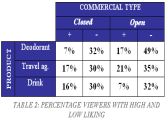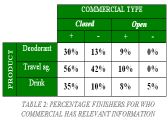WHAT IS YOUR STORY?
|
 |

|

|
Commercials that raise questions
How is it possible to maintain consumers' attention? An increasingly occurring strategy is using puzzling commercials. For example, in the 'Odyssee' commercial, advertising for Levi's jeans, viewers have to discover themselves why two people are running through walls, among trees and 'in the air'. Advertisers don't explain explicitly what this unrealistic situation has got to do with wearing or not wearing Levi's jeans. Also NBBS used to advertise for a long time by putting people in the water on the edge of a waterfall, with almost no explanation, except for the pay-off: “What's your story?” These are some examples of commercials, raising questions about their message, regardless the messages affective or informative nature (for an example, click here).
 |

|

|
Reward
The use of riddles in commercials is aimed at arousing the public's curiosity for the advertiser's intention. Because viewers have to search for meaning, they are triggered to look at the commercial in search for clues offering a solution. Therefore, puzzling commercials ought to have a positive effect on attention. A subordinate advantage is the possible arousal of feelings of joy by unravelling the commercial, which increases attention and is transmitted to the brand. Besides, riddles may prevent contra-argumentation. Time spent on searching for a clue, prevents discussing the commercial's message. Also, viewers might feel they are taken seriously because they are not confronted with endlessly repeated literal messages. Finally, their effort to discover the message might result in better recall. But the necessity of some sort of cognitive effort is also dangerous. Are viewers willing to puzzle when they already know the reward is a familiar and commercial message? There is a chance that especially messages which require some effort, will be ignored, or according to researcher Schaefer: “Readers are grateful for any indication that they may skip an article or ad”. And what will happen if comprehension of an ad does not take place? Irritation caused by this lack of understanding might prevent consumers to continue viewing the commercial.
 |

|

|
Drop-outs and finalists
We describe puzzling commercials as: 'more open commercials, in which consumers are not manifestly directed to a certain message.' In 'more closed' commercials this guidance is more obvious because a certain preferred interpretation is encouraged. After an extensive pre-test, three open and three closed commercials were selected. The selected commercials advertise for the same product (travel agency, deodorant and probiotic drink) and do not differ – or at least no more than 5 seconds- in length of time. Attention for these six commercials was measured by Verify Netherlands. Viewers were exposed to different commercials (in random order). They could finish watching the commercial or choose to prematurely interrupt viewing and switch to the next commercial. Besides viewing time and the percentage of drop-outs and finalists, we asked questions at the end of the commercial or after viewers had interrupted the commercial, to measure their liking of the commercial and amount of acquired relevant information. We also measured if respondents had seen the commercials before, and if so, how many times they had seen these commercials. During this study every commercial was viewed by at least 67 respondents and at most 121 respondents. Afterwards, 14 respondents were interviewed to determine their reasons to finish or not finish watching the test-commercials.
Less information more attention
The results show that open commercials tend to keep attention better. All open commercials are being watched for a longer period than their closed counterparts. Also, more viewers sit through an open commercial (see table 1), regardless the viewer's familiarity with the commercial.
 It is unclear if this is caused by presence of a riddle or other differences between the commercials like presence or absence of humour or nudity. The qualitative study, however, showed that in open commercials mainly presence of a riddle and novelty effect attention positively. People seem to pay more attention to open commercials.
It is unclear if this is caused by presence of a riddle or other differences between the commercials like presence or absence of humour or nudity. The qualitative study, however, showed that in open commercials mainly presence of a riddle and novelty effect attention positively. People seem to pay more attention to open commercials.The results also show that on average 'finalists' evaluate all commercials more positive than 'drop-outs'. This suggests that liking has an important influence on attention. Does the riddle maintain more attention because the viewer is just curious, or because he also enjoys solving the riddle?
 When we look at the attitude towards the tested commercials, it is striking that all commercials are rated relatively low. So it takes a lot of effort to produce commercials that are appreciated anyhow. Open commercials elicit more emotions, both positive and negative (see table 2). A remarkable result is that only for the probiotic drink commercial the closed commercial was evaluated more positive than the open commercial. This might be explained by the presence of (male) nudity in this particular commercial. Therefore, open commercials are not liked more by definition.
When we look at the attitude towards the tested commercials, it is striking that all commercials are rated relatively low. So it takes a lot of effort to produce commercials that are appreciated anyhow. Open commercials elicit more emotions, both positive and negative (see table 2). A remarkable result is that only for the probiotic drink commercial the closed commercial was evaluated more positive than the open commercial. This might be explained by the presence of (male) nudity in this particular commercial. Therefore, open commercials are not liked more by definition.
This also depends on whether the viewer is able to create a plausible interpretation. Whether the viewer comprehends the commercial is partly based on whether the commercial provides the viewer with relevant information.
 The Verify measures show that the open commercials provide viewers with less relevant information than the closed commercials. Also, commercials seem to provide more relevant information for 'finishers' than for 'zappers' (see table 3). This might confirm the thought that thinking about a commercial is fun to a certain extent. If thinking leads to nothing but incomprehension, there's a risk of irritation and decreasing attention. The qualitative interviews went further into the relationship between comprehension and evaluation.
The Verify measures show that the open commercials provide viewers with less relevant information than the closed commercials. Also, commercials seem to provide more relevant information for 'finishers' than for 'zappers' (see table 3). This might confirm the thought that thinking about a commercial is fun to a certain extent. If thinking leads to nothing but incomprehension, there's a risk of irritation and decreasing attention. The qualitative interviews went further into the relationship between comprehension and evaluation.
Did I miss something?
The interviews show that open commercials not just elicit more different interpretations, but also more often result in lack of understanding. This feeling of incomprehension leads to different reactions. Finding an interpretation is not of importance for everyone. Some get sufficient gratification in their search for meaning, which sometimes has a positive effect on their attention: “Can I see the commercial again? Maybe I missed something.” However, most viewers want to discover the advertiser's intention. If it remains unclear what the commercial tries to communicate about the brand, especially after putting some effort into it, irritation occurs which can lead to less attention. “If I do not understand a commercial, I think 'too bad' and zap away”. In conclusion, open commercials seem to get more attention, but aren't always liked more, because constructing a plausible interpretation is sometimes too difficult. However, in order to draw more valid conclusions future research is necessary by which test commercials vary less in different variables and the target group is taken more into account. For the time being it's up to advertisers to produce commercials that challenge viewers to think about the commercials' message, but that aren't too hard to interpret and therfore cause irritation.
[Translated: Riddles against zapping]. Tijdschrift voor Marketing, 3(37), p.44-46
|
|